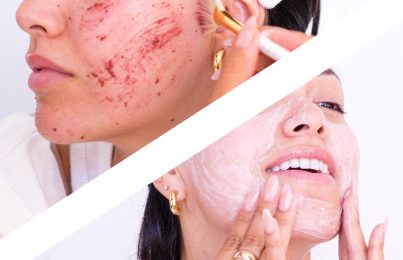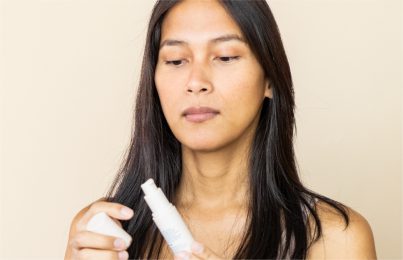Updated 11/21/23. There’s nothing more frustrating than working hard to get your skin on track only for it to be derailed again by irritation. Maybe you tried a new product and had a negative reaction. Maybe you traveled to a different climate, or you’re in the middle of a seasonal transition. Perhaps you got a professional chemical peel and your skin needs some TLC. Or, maybe enthusiasm got the best of you and you just overdid it on retinol or exfoliants (hey, it happens to the best of us).
- 9 Tips for Quickly Calming Irritated Skin on Your Face
- 1. Simplify Your Routine
- 2. Stick to Creamy-Textured Cleansers
- 3. Cut Out the Acid Toners, Opt for Something Hydrating
- 4. Put a Pause on Active Ingredients
- 5. Decide Whether Your Skin is Dry, Dehydrated, or Both
- 6. Use a Facial Oil
- 7. Try a Targeted Face Mask
- 8. Negative Reaction? Try a Little Hydrocortisone Cream
- 9. Harness the Power of Cold
No matter how it happened, these nine easy tips will help you quickly get irritated skin back on track. Let’s dive in!
9 Tips for Quickly Calming Irritated Skin on Your Face
When your skin is angry, uncomfortable, and irritated, less is always more. It’s all about taking it back to the basics, removing possible irritants, and ultimately replenishing what’s been lost. Here’s how to go about it.
1. Simplify Your Routine
Like I said, the first thing you want to do is take it back to basics. Cut out all the bells and whistles (for now) and pare your routine down to a simple cleanser, toner, and moisturizer. Depending on your skin’s needs, you may also want to add a specialty serum or mask to help speed up recovery (more on that later).
How long you follow this simplified version of your routine will depend on a lot of different factors. I would follow it for a minimum of two days, then gauge the state of your skin. As long as you’re still experiencing any redness, stinging, flaking, or other signs of irritation, stick to your simplified routine.
If your irritation takes a long time to improve or keeps coming back, you could have a damaged moisture barrier. If things don’t improve, you may also want to have your dermatologist check for any underlying conditions, such as eczema or rosacea.
2. Stick to Creamy-Textured Cleansers
If you have one, this is a good time to use a cream or lotion cleanser. Gels are really good at breaking down oils and while this is normally a good thing, when your skin is irritated, you want to retain your natural oils a little more to keep it protected.
3. Cut Out the Acid Toners, Opt for Something Hydrating
I know toners with exfoliating acids are popular, but when your skin is in a delicate state this isn’t a product you should be using. Since these products are water-based, they penetrate pretty quickly and give skin a “quick hit” of exfoliating acids. While this can lead to instant (and admittedly gratifying) results, it can also put your skin under unnecessary stress.
Instead, I’m a huge proponent of hydrating, alcohol-free toners. They can be a good tool for combatting irritation when used after cleansing. Tap water can contain chlorine and other minerals that may irritate skin, and wiping your face with an alcohol-free toner is a good way to remove these. In addition, you can choose a toner with soothing, restorative ingredients to help get your skin back on track.
For oily to combination skin types (like skin types #1-4), I recommend Elderberry Soothing Toner. If your skin is normal to dry (like skin types #5-9), try Moisture Infusion Toner. Both toners include soothing ingredients that focus on comforting irritated skin.
4. Put a Pause on Active Ingredients
Exfoliating toners aren’t the only thing you’ll want to stop using while trying to calm irritated skin. Put a pause on your active ingredients such as vitamin C, retinol, exfoliating acids, and enzymes. I would also leave out any kind of physical face scrub or polish at this point.
Remember that in the skincare hierarchy, irritation should be addressed before anything else. Your active ingredients can’t improve your skin if they’re making your irritation worse!
5. Decide Whether Your Skin is Dry, Dehydrated, or Both
When your skin is in a compromised state you need to replenish what’s been lost. This is usually lipids (oils), water, or both. Remember that skin needs a good balance of both oil and water to be healthy. If you don’t have enough water, your skin becomes dehydrated. A lack of oil means your skin is dry. Both can lead to a damaged moisture barrier, which is the root cause of most irritation.
Understanding the difference between dry versus dehydrated skin is key because it will help you determine which products you should use to get your skin back on track. If your skin is showing signs of dehydration, you’ll want to focus on water-based products (like toners and serums) with humectant ingredients such as glycerin or hyaluronic acid. If your skin is dry, you’ll want to use a moisturizer with ingredients like plant oils, ceramides, squalane, or vitamin E.
6. Use a Facial Oil
One quick and easy way to add more oomph to your moisturizer and comfort irritated skin is to add a few drops of face oil on top. This is also a good way for those with oily or combination skin to get the barrier-repairing benefits of an oil without risking clogged pores.
Note: The only time I wouldn’t suggest this would be if you just got a chemical peel. Depending on the strength of the peel, flaking is part of the side effect as your skin tries to shed old, dead cells to make way for new ones. Over-hydrating the skin can prolong this process, just use your regular moisturizer and let things take their course.
7. Try a Targeted Face Mask
One thing I love about face masks is that they can be added to your routine at any time to address a temporary concern. To address irritation, I love a soothing gel mask. They retain cold temperatures, which can be comforting to stressed-out skin, and they help deliver hydration deep within the skin.
Bio Calm Repair Masque is a good option for any skin type thanks to its addition of green tea and comfrey leaf, both of which address inflammation.
8. Negative Reaction? Try a Little Hydrocortisone Cream
If you think you had a negative reaction to a new product, try mixing a pea-sized amount of hydrocortisone cream in with your moisturizer. This can help take down any redness, swelling, or itching.
To avoid making the same mistake twice, here’s how to avoid a negative reaction to a new product.
9. Harness the Power of Cold
When your skin is irritated, cooling it down is a quick way to provide some relief and get it on track for healing. Cold temperatures can help soothe inflammation and also restrict blood vessels, which can help with redness.
Try putting gel products (like face masks) in the fridge before applying them, or try my DIY toner hack! Tools like jade rollers also retain cold temperatures really well when kept in the fridge, but even a metal spoon works in a pinch!
Irritated skin is no fun to deal with, but it can happen to anyone. Sometimes we overdo it, and sometimes our environment just takes a toll. Regardless, I hope these tips help you get back on track!
Next, read about the four different types of skin sensitivity (and how to manage them).
Celebrity Esthetician & Skincare Expert
As an esthetician trained in cosmetic chemistry, Renée Rouleau has spent 30 years researching skin, educating her audience, and building an award-winning line of products. Her hands-on experience as an esthetician and trusted skin care expert has created a real-world solution — products that are formulated for nine different types of skin so your face will get exactly what it needs to look and feel its best. Trusted by celebrities, editors, bloggers, and skincare obsessives around the globe, her vast real-world knowledge and constant research are why Marie Claire calls her “the most passionate skin practitioner we know.”




Comments:
Great tips! I’ve been struggling with redness lately, and I can’t wait to try the aloe vera suggestion. Thanks for sharing the soothing techniques!
Posted By: 91 club official |
Great tips! I especially loved the suggestion about using green tea compresses. I’ve tried a few of these methods before, but I’m excited to incorporate more of them into my routine. Thanks for sharing!
Posted By: Tiny Fishing |